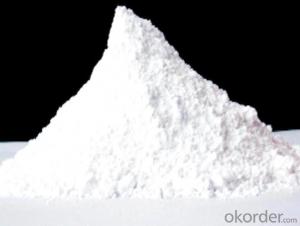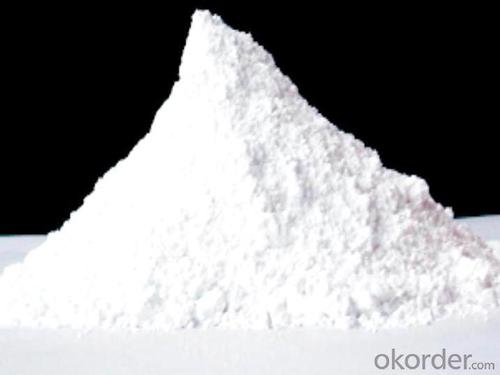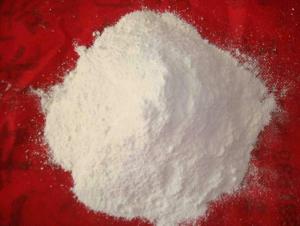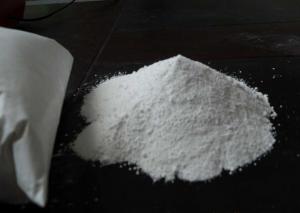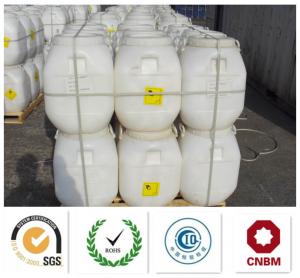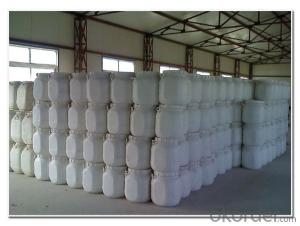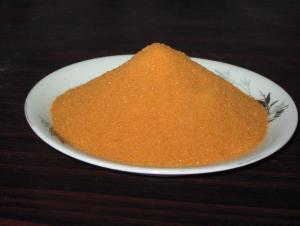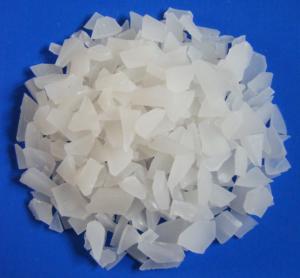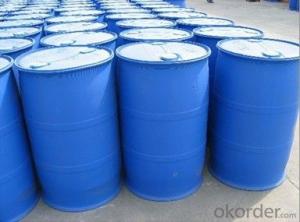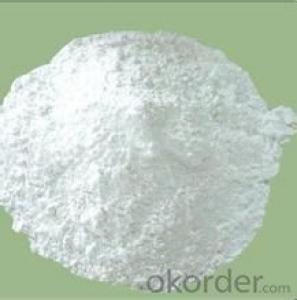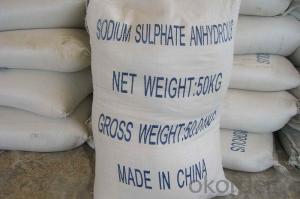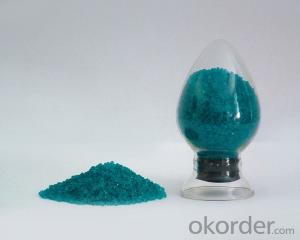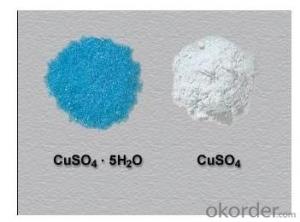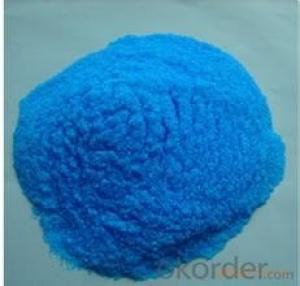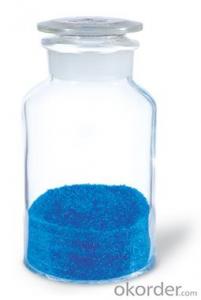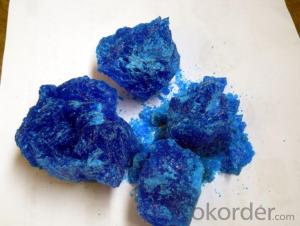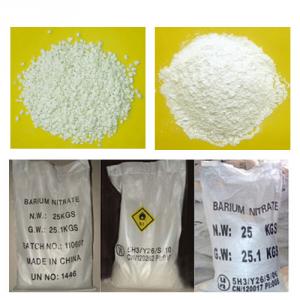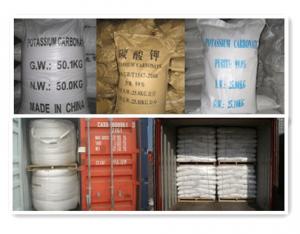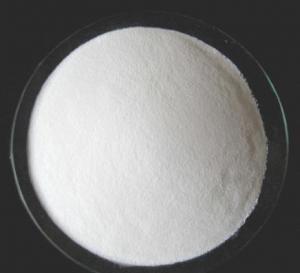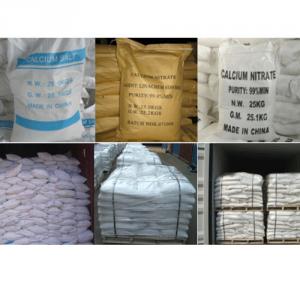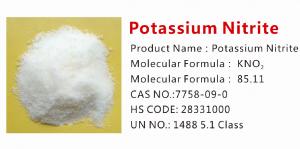sodium sulphate anhydrous 99%
- Loading Port:
- Shanghai
- Payment Terms:
- TT OR LC
- Min Order Qty:
- -
- Supply Capability:
- 1000MT m.t./month
OKorder Service Pledge
OKorder Financial Service
You Might Also Like
Specifications
min 99% ph9-11 Sodium Sulphate Anhydrous is mainly used for detergent, paper,glass, and other Industry
EXAMINE ITEM | STANDARD NUMBER | MEASURED NUMBER |
Appearance ISO Brightness |
85MIN |
87 |
PH of 1% solution | 9.0-11.0 | 9.3 |
Moisture | 0.20%MAX | 0.05% |
Purity as Na2So4 | 99%MIN | 99.1% |
Water Insoluble | 0.05%MAX | 0.02% |
Chloride as Nacl | 0.35%MAX | 0.23% |
(Ca+Mg)as Mg | 0.30% MAX | 0.02% |
Iron as Fe | 0.002%MAX | 0.001% |
Product Description
sodium sulphate anhydrous
Classification: Sulphate Type: sodium sulphate
CAS No.: CAS: 15124-09-1
Other Names: Sodium Sulfate MF: NA2SO4
EINECS No.: 231-820-9
Place of Origin: China (Mainland)
Grade Standard: Industrial Grade Purity: 99%
Appearance: White powder
Application: Detergent
Classification: Sodium Sulphate
Packaging and shipment : 25kg/50kg/jumbo/ bag Shipment: 26.95mts/20FCL
- Q: The stronger the transpiration is, the faster the absorption rate of inorganic salts and water is
- wrong. Can only promote the transport up! Can not promote absorption.
- Q: What are the important physiological effects of inorganic salts in cells
- Maintain the normal life of the organism
- Q: Definition of inorganic salts
- In addition to hydrogen, oxygen, nitrogen, carbon, sulfur, organic compounds other than organic compounds are collectively referred to as inorganic salts. The inorganic salts required by the human body, according to the content in the body, divided into essential elements (hydrogen, oxygen, nitrogen, , Magnesium, phosphorus, chlorine, potassium, sodium 11) in the human body content, the need for larger also known as macro elements of the source 2, the rest of the various elements, regardless of content, can be collectively referred to as inorganic salts. More elements such as iron, magnesium, potassium, sodium, phosphorus, sulfur, chlorine and other elements, other elements such as iron, copper, iodine, zinc, manganese, drilling, etc., due to the existence of a small number, and some even trace Known as trace elements, 3, what is the "inorganic salt", the body contains elements in addition to carbon, hydrogen, oxygen three elements mainly in the form of organic matter, the rest of the various elements are in the form of inorganic matter, collectively referred to as inorganic Salts such as calcium, magnesium, potassium, sodium, phosphorus, scratch, sulfur and the like
- Q: What are minerals and trace elements?
- Trace elements, although not much in the human body, but closely related to human survival and health. Their intake of excessive, inadequate, or lack of will cause varying degrees of human physiological abnormalities or disease. The most prominent role of trace elements is closely related to the vitality of life, just like the size of the matchhead or less the amount can play a huge physiological role. It is worth noting that these trace elements must be supplied directly or indirectly from the soil. According to scientific research, so far, due to the use of pesticide overdose, resulting in a large number of trace elements loss, so we have to indirectly add trace elements, the use of mineral power to supplement the lack of trace elements in the human body. There are 18 kinds of essential trace elements related to the detection of human health and life, namely iron, copper, zinc, cobalt, manganese, chromium, selenium, iodine, nickel, fluorine, molybdenum, vanadium, tin, silicon, strontium, Rubidium, arsenic and so on. Each of these trace elements has its own special physiological function. Although they are extremely small in the human body, they are necessary to maintain some of the decisive metabolism in the human body. Once the lack of these essential minerals trace elements, the body will be disease, and even life-threatening. Such as zinc deficiency can cause mouth, eyes, anus or genital redness, pimples, rash. Another example is iron is one of the main components of hemoglobin, iron deficiency can cause iron deficiency anemia. Abroad has been reported: the body of iron, copper, zinc reduction, can weaken the immune mechanism (resistance to disease), reduce disease resistance, contribute to bacterial infection, and infection after the mortality rate is also higher. Trace elements in disease resistance, anti-cancer, longevity and other aspects also play a role can not be ignored.
- Q: An inorganic salt is dissolved in water and yields a solution that has a color. Make a statement about the type of element the substance contains that casuses the color.Thanks!
- Many inorganic salts form colored solutions . pper ( II) sulfate ( Blue ) nickel (II) acetate = green, mangaanse ( II) chloride = pink, iron(III) chloride = yellow, potassium dichromate, orange and so many more Can you be more specific ?
- Q: Please help me!
- This is because NaCl does not contain Carbon. It is usually compounds that contain Carbon which can be considered ORGANIC compounds. :)
- Q: The inorganic salt is composed of?
- Inorganic salts are the general term for various inorganic salts. They are composed of inorganic acid radicals and metal cations or ammonium salts, mainly salts of organic acid salts, such as sodium chloride, potassium chloride and so on.
- Q: What is the disease of inorganic salt crystals?
- It is recommended to drink boiled water.No need to take medication.
- Q: What are the main physiological functions of inorganic salts?
- o maintain the body acid and alkali balance and osmotic pressur
- Q: as a example potesium,sodium,magnees,calcium
- The sodium-potassium pump is most important in controlling the working of neurotransmitters. Calcium ion is also generated in voltage gated Ca++ channel, and Magnesium is necessary for metabolic functions. But Sodium is one of the most important inorganic component in our body. Of course Potassium is also as important. But, if you have ever seen the back of all food products there is a special part showing amount of Sodium in it...even Snacks.. :)
Send your message to us
sodium sulphate anhydrous 99%
- Loading Port:
- Shanghai
- Payment Terms:
- TT OR LC
- Min Order Qty:
- -
- Supply Capability:
- 1000MT m.t./month
OKorder Service Pledge
OKorder Financial Service
Similar products
Hot products
Hot Searches
Related keywords
